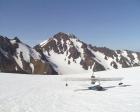
My aircraft as I found it safe after the winter. It is the one on the
left with the wings hanging on the wall.

Where I landed on the glacier on Kambalnoe Volcano.

Another shot on the glacier.
(Click on any Image to see a higher resolution version)
This is my forth year flying in Russia. Despite the hardships and challenges we have faced, I see the opportunity to fly here as one of several spectacular privileges that have been granted us. With no more than a few tools and a couple of ingenious Russian friends to solve problems when they present themselves, I keep going. (Also see An Airplane as a Tool in the Wilderness). It is mostly a testimony to the design of the Kolb Mark III aircraft that I built 9 years ago and the Rotax 912 which has pushed me along almost without a hitch. The first two years of flying, it quit now and then due to trying to operate on the fuel available in Petropavlosk. This was obviously not a problem of the engine. Business men in that city were buying low quality fuel in Seattle Wash. and then taking advantage of the rough trip back to Russia with their tanker to have the wave action mix in up with 25% cheaper diesel fuel. They then sold it as premium American gas. Since the August 17th 1998 meltdown of the economy, all that is available is the leaded Russian variety. I solve my problem by bringing a few barrels from Seattle each spring.
Surprisingly, the one thing that I don't worry about during the winter while back in Canada, is whether my aircraft is being taken care of while I am away for the winter. These people, who I trust, run the flying school in an outlying village 30kl from P.K. and are all nuts about flying. They design and build their own personal aircraft while instructing with Blanic gliders, Wilga for general flying and Yaks for aerobatics. Each October my plane is tucked away in a garage and only my friend Volodia has the key. He carefully prepares the engine against corrosion during the long winter and goes over the plane to see if he can spot problems that should be taken care of before it is flown again in the spring. The battery is stored in their warm shop to prevent it from freezing.
When I arrive in May I get ample help to ensure that my seasons flying is without mechanical surprises. Even so, when I take off after a test fly and head south it is not without some feelings of trepidation. Its a lot to ask of this small craft to withstand the rigors of weather near Lopatca, one of the worlds foulest weather areas. Many of the helicopter pilots that I have flown with here bring out a map when they come over the pass leading to Kambalnoe, having avoided flying there until they had to come on our charters. Still it is our chief means of support and a wonderful tool for our work.
On days like we just had of unusually calm weather it is a joy to fly here. In the open country stretching away from the mountains out to the sea, little can hide from me. One afternoon during a previous August, I counted 171 bears in four hours while hauling wood from the coast that I had cut to warm the cabin. Two days ago I counted 35 bears in two minutes in a stretch of a mile and a half along the river. There were five big males all cheek to jowl in the falls where we often hike. The salmon are here.
I also recently completed my once a month survey of a hundred miles of rugged coast to check for a possible dead whale washed up on shore. It happens occasionally but so far I have only found live ones, Grays, Minky, and Fin. The reason I keep watch is because of the spectacle that this creates with the bears propensity to feed on the carcass. The year before we first came here a Blue whale washed up and there were 60 Grizzlies feeding on it. We don't want to miss seeing that if we should be lucky enough to have one come ashore while we are here. I'll never forget a description of this same phenomenon in a book called "California Grizzly" of bears feeding on a whale at Big Sur in the late 1700s.
Taking advantage of the calm clear weather I did something that I have wanted to do for some years. This was to land on a high glacier on Kambalnoe Volcano. It required landing on a rather steep slope which means approaching it at high speed and swooping up for the touchdown, while hoping not to be surprised by a gust of katabatic wind. These are caused by pools of cold dense air that form on glaciers. Because this air is heavy it periodically slides off down the valley with great velocity. This is why if you look in the pictures that I attach this week, you can see that I chose a place to land out to the side of the basin. Surprisingly, there were many bear tracks on the snow as high as 6500 feet. I came over top of a bear as I landed at 5500 feet. There is no food that I could see but not far along the ridge there is a geyser basin where the thermal heat brings on green grass even before it appears at the valley bottom.
We are now into another few foggy days with a lot of wind and rain. Maureen just baked some bread in an oven that goes on top of our gas stove. It is wonderful. We soon will have fresh salmon.
Charlie